University of Suffolk: Business Communication Organisational Report
VerifiedAdded on 2023/01/12
|7
|1371
|45
Report
AI Summary
This report on organisational communication provides a comprehensive analysis of its importance, particularly for Go Travel. The introduction establishes the significance of effective communication in business planning and management. The literature review explores relevant theories and concepts. The report then delves into communication theories, including fixed structures, organisation control, and Deetz's Managerialism theory, along with the 7 Cs of communication. It evaluates communication practices such as video conferencing and written communication, while also addressing barriers like language and cultural differences. The application of communication principles to improve practices is discussed, with strategies to overcome identified barriers. The report concludes with a summary of findings and emphasizes the importance of clear, concise, and courteous communication. The report also suggests that the company is facing language and cultural barriers which need to be addressed.
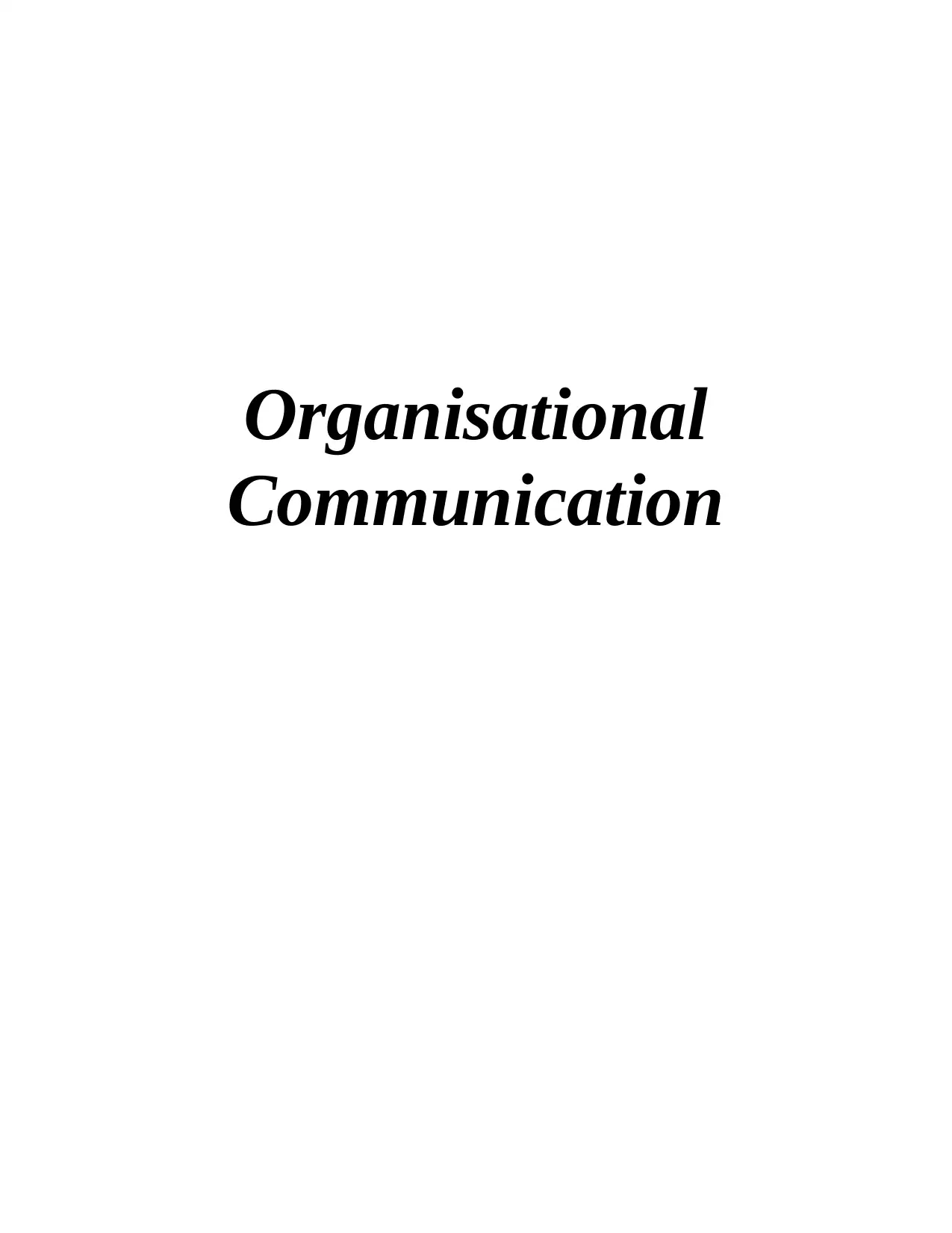
Organisational
Communication
Communication
Paraphrase This Document
Need a fresh take? Get an instant paraphrase of this document with our AI Paraphraser
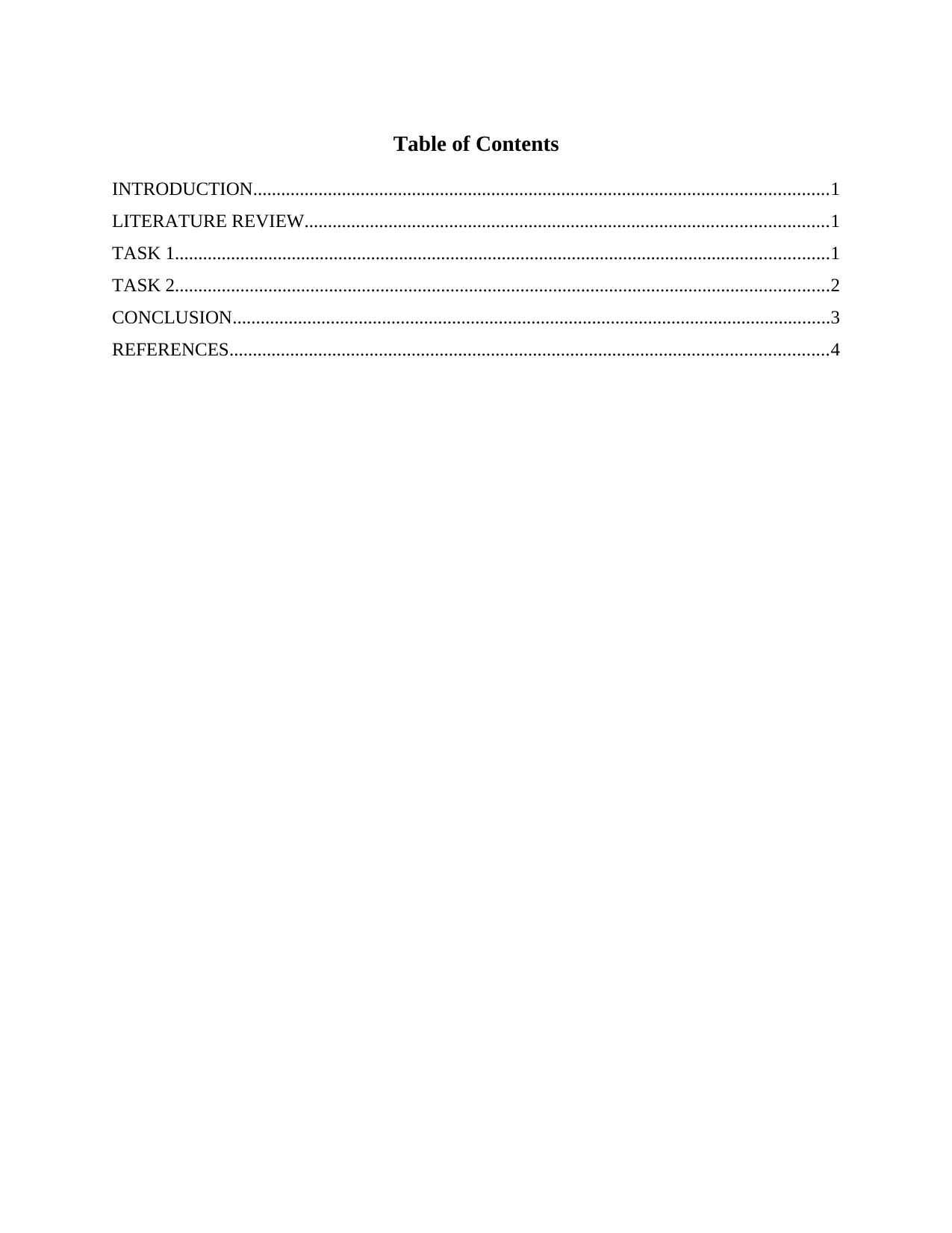
Table of Contents
INTRODUCTION...........................................................................................................................1
LITERATURE REVIEW................................................................................................................1
TASK 1............................................................................................................................................1
TASK 2............................................................................................................................................2
CONCLUSION................................................................................................................................3
REFERENCES................................................................................................................................4
INTRODUCTION...........................................................................................................................1
LITERATURE REVIEW................................................................................................................1
TASK 1............................................................................................................................................1
TASK 2............................................................................................................................................2
CONCLUSION................................................................................................................................3
REFERENCES................................................................................................................................4
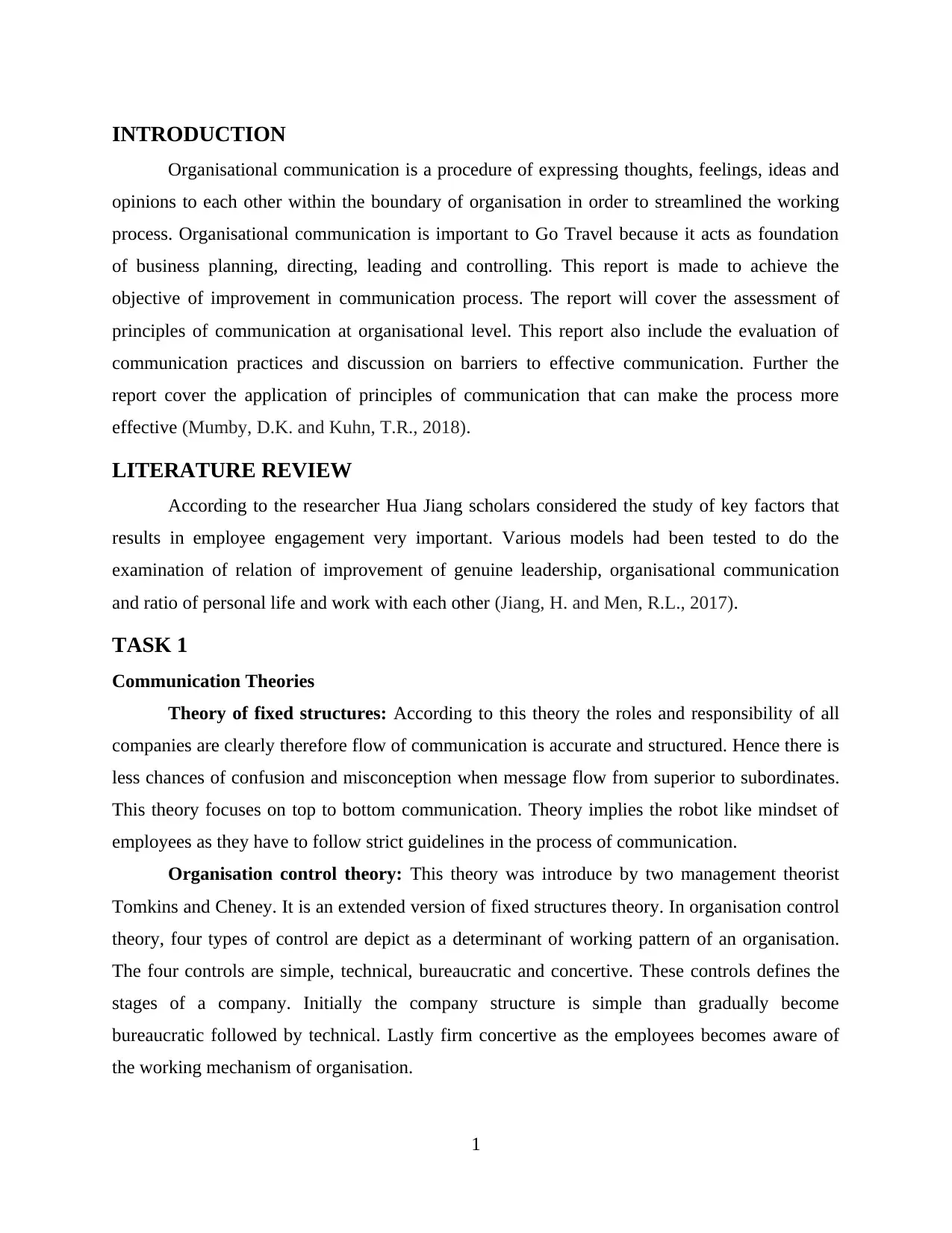
INTRODUCTION
Organisational communication is a procedure of expressing thoughts, feelings, ideas and
opinions to each other within the boundary of organisation in order to streamlined the working
process. Organisational communication is important to Go Travel because it acts as foundation
of business planning, directing, leading and controlling. This report is made to achieve the
objective of improvement in communication process. The report will cover the assessment of
principles of communication at organisational level. This report also include the evaluation of
communication practices and discussion on barriers to effective communication. Further the
report cover the application of principles of communication that can make the process more
effective (Mumby, D.K. and Kuhn, T.R., 2018).
LITERATURE REVIEW
According to the researcher Hua Jiang scholars considered the study of key factors that
results in employee engagement very important. Various models had been tested to do the
examination of relation of improvement of genuine leadership, organisational communication
and ratio of personal life and work with each other (Jiang, H. and Men, R.L., 2017).
TASK 1
Communication Theories
Theory of fixed structures: According to this theory the roles and responsibility of all
companies are clearly therefore flow of communication is accurate and structured. Hence there is
less chances of confusion and misconception when message flow from superior to subordinates.
This theory focuses on top to bottom communication. Theory implies the robot like mindset of
employees as they have to follow strict guidelines in the process of communication.
Organisation control theory: This theory was introduce by two management theorist
Tomkins and Cheney. It is an extended version of fixed structures theory. In organisation control
theory, four types of control are depict as a determinant of working pattern of an organisation.
The four controls are simple, technical, bureaucratic and concertive. These controls defines the
stages of a company. Initially the company structure is simple than gradually become
bureaucratic followed by technical. Lastly firm concertive as the employees becomes aware of
the working mechanism of organisation.
1
Organisational communication is a procedure of expressing thoughts, feelings, ideas and
opinions to each other within the boundary of organisation in order to streamlined the working
process. Organisational communication is important to Go Travel because it acts as foundation
of business planning, directing, leading and controlling. This report is made to achieve the
objective of improvement in communication process. The report will cover the assessment of
principles of communication at organisational level. This report also include the evaluation of
communication practices and discussion on barriers to effective communication. Further the
report cover the application of principles of communication that can make the process more
effective (Mumby, D.K. and Kuhn, T.R., 2018).
LITERATURE REVIEW
According to the researcher Hua Jiang scholars considered the study of key factors that
results in employee engagement very important. Various models had been tested to do the
examination of relation of improvement of genuine leadership, organisational communication
and ratio of personal life and work with each other (Jiang, H. and Men, R.L., 2017).
TASK 1
Communication Theories
Theory of fixed structures: According to this theory the roles and responsibility of all
companies are clearly therefore flow of communication is accurate and structured. Hence there is
less chances of confusion and misconception when message flow from superior to subordinates.
This theory focuses on top to bottom communication. Theory implies the robot like mindset of
employees as they have to follow strict guidelines in the process of communication.
Organisation control theory: This theory was introduce by two management theorist
Tomkins and Cheney. It is an extended version of fixed structures theory. In organisation control
theory, four types of control are depict as a determinant of working pattern of an organisation.
The four controls are simple, technical, bureaucratic and concertive. These controls defines the
stages of a company. Initially the company structure is simple than gradually become
bureaucratic followed by technical. Lastly firm concertive as the employees becomes aware of
the working mechanism of organisation.
1
⊘ This is a preview!⊘
Do you want full access?
Subscribe today to unlock all pages.

Trusted by 1+ million students worldwide
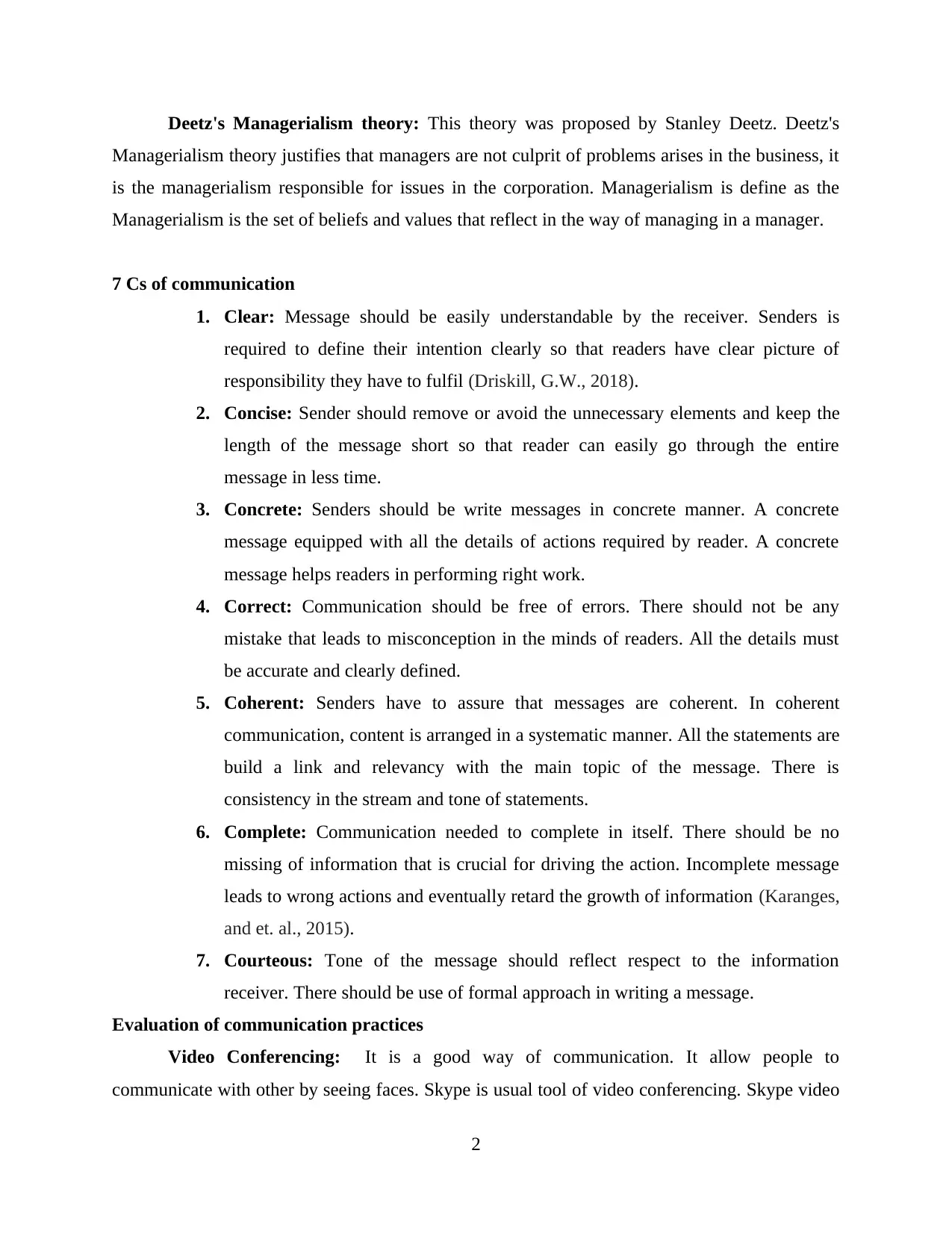
Deetz's Managerialism theory: This theory was proposed by Stanley Deetz. Deetz's
Managerialism theory justifies that managers are not culprit of problems arises in the business, it
is the managerialism responsible for issues in the corporation. Managerialism is define as the
Managerialism is the set of beliefs and values that reflect in the way of managing in a manager.
7 Cs of communication
1. Clear: Message should be easily understandable by the receiver. Senders is
required to define their intention clearly so that readers have clear picture of
responsibility they have to fulfil (Driskill, G.W., 2018).
2. Concise: Sender should remove or avoid the unnecessary elements and keep the
length of the message short so that reader can easily go through the entire
message in less time.
3. Concrete: Senders should be write messages in concrete manner. A concrete
message equipped with all the details of actions required by reader. A concrete
message helps readers in performing right work.
4. Correct: Communication should be free of errors. There should not be any
mistake that leads to misconception in the minds of readers. All the details must
be accurate and clearly defined.
5. Coherent: Senders have to assure that messages are coherent. In coherent
communication, content is arranged in a systematic manner. All the statements are
build a link and relevancy with the main topic of the message. There is
consistency in the stream and tone of statements.
6. Complete: Communication needed to complete in itself. There should be no
missing of information that is crucial for driving the action. Incomplete message
leads to wrong actions and eventually retard the growth of information (Karanges,
and et. al., 2015).
7. Courteous: Tone of the message should reflect respect to the information
receiver. There should be use of formal approach in writing a message.
Evaluation of communication practices
Video Conferencing: It is a good way of communication. It allow people to
communicate with other by seeing faces. Skype is usual tool of video conferencing. Skype video
2
Managerialism theory justifies that managers are not culprit of problems arises in the business, it
is the managerialism responsible for issues in the corporation. Managerialism is define as the
Managerialism is the set of beliefs and values that reflect in the way of managing in a manager.
7 Cs of communication
1. Clear: Message should be easily understandable by the receiver. Senders is
required to define their intention clearly so that readers have clear picture of
responsibility they have to fulfil (Driskill, G.W., 2018).
2. Concise: Sender should remove or avoid the unnecessary elements and keep the
length of the message short so that reader can easily go through the entire
message in less time.
3. Concrete: Senders should be write messages in concrete manner. A concrete
message equipped with all the details of actions required by reader. A concrete
message helps readers in performing right work.
4. Correct: Communication should be free of errors. There should not be any
mistake that leads to misconception in the minds of readers. All the details must
be accurate and clearly defined.
5. Coherent: Senders have to assure that messages are coherent. In coherent
communication, content is arranged in a systematic manner. All the statements are
build a link and relevancy with the main topic of the message. There is
consistency in the stream and tone of statements.
6. Complete: Communication needed to complete in itself. There should be no
missing of information that is crucial for driving the action. Incomplete message
leads to wrong actions and eventually retard the growth of information (Karanges,
and et. al., 2015).
7. Courteous: Tone of the message should reflect respect to the information
receiver. There should be use of formal approach in writing a message.
Evaluation of communication practices
Video Conferencing: It is a good way of communication. It allow people to
communicate with other by seeing faces. Skype is usual tool of video conferencing. Skype video
2
Paraphrase This Document
Need a fresh take? Get an instant paraphrase of this document with our AI Paraphraser
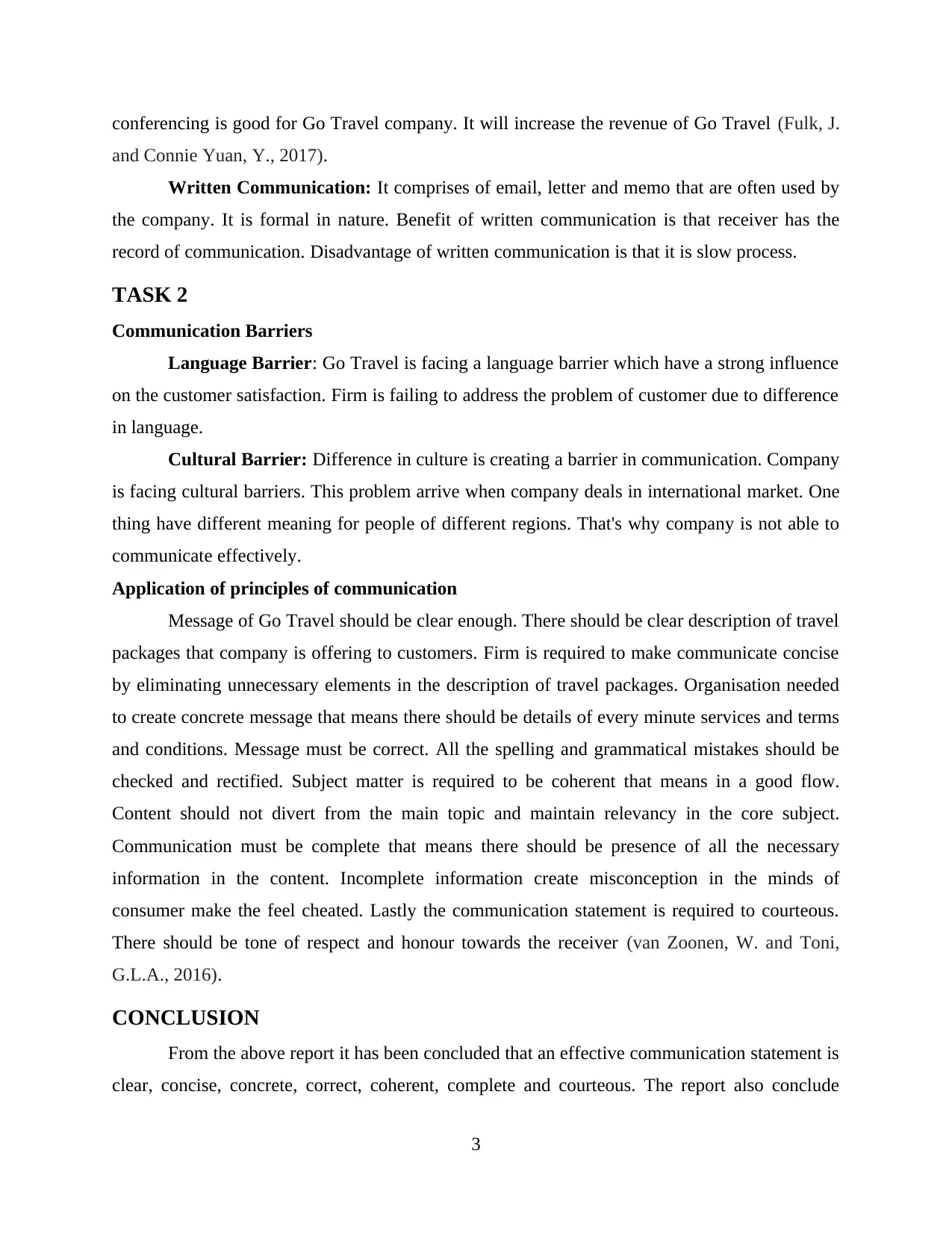
conferencing is good for Go Travel company. It will increase the revenue of Go Travel (Fulk, J.
and Connie Yuan, Y., 2017).
Written Communication: It comprises of email, letter and memo that are often used by
the company. It is formal in nature. Benefit of written communication is that receiver has the
record of communication. Disadvantage of written communication is that it is slow process.
TASK 2
Communication Barriers
Language Barrier: Go Travel is facing a language barrier which have a strong influence
on the customer satisfaction. Firm is failing to address the problem of customer due to difference
in language.
Cultural Barrier: Difference in culture is creating a barrier in communication. Company
is facing cultural barriers. This problem arrive when company deals in international market. One
thing have different meaning for people of different regions. That's why company is not able to
communicate effectively.
Application of principles of communication
Message of Go Travel should be clear enough. There should be clear description of travel
packages that company is offering to customers. Firm is required to make communicate concise
by eliminating unnecessary elements in the description of travel packages. Organisation needed
to create concrete message that means there should be details of every minute services and terms
and conditions. Message must be correct. All the spelling and grammatical mistakes should be
checked and rectified. Subject matter is required to be coherent that means in a good flow.
Content should not divert from the main topic and maintain relevancy in the core subject.
Communication must be complete that means there should be presence of all the necessary
information in the content. Incomplete information create misconception in the minds of
consumer make the feel cheated. Lastly the communication statement is required to courteous.
There should be tone of respect and honour towards the receiver (van Zoonen, W. and Toni,
G.L.A., 2016).
CONCLUSION
From the above report it has been concluded that an effective communication statement is
clear, concise, concrete, correct, coherent, complete and courteous. The report also conclude
3
and Connie Yuan, Y., 2017).
Written Communication: It comprises of email, letter and memo that are often used by
the company. It is formal in nature. Benefit of written communication is that receiver has the
record of communication. Disadvantage of written communication is that it is slow process.
TASK 2
Communication Barriers
Language Barrier: Go Travel is facing a language barrier which have a strong influence
on the customer satisfaction. Firm is failing to address the problem of customer due to difference
in language.
Cultural Barrier: Difference in culture is creating a barrier in communication. Company
is facing cultural barriers. This problem arrive when company deals in international market. One
thing have different meaning for people of different regions. That's why company is not able to
communicate effectively.
Application of principles of communication
Message of Go Travel should be clear enough. There should be clear description of travel
packages that company is offering to customers. Firm is required to make communicate concise
by eliminating unnecessary elements in the description of travel packages. Organisation needed
to create concrete message that means there should be details of every minute services and terms
and conditions. Message must be correct. All the spelling and grammatical mistakes should be
checked and rectified. Subject matter is required to be coherent that means in a good flow.
Content should not divert from the main topic and maintain relevancy in the core subject.
Communication must be complete that means there should be presence of all the necessary
information in the content. Incomplete information create misconception in the minds of
consumer make the feel cheated. Lastly the communication statement is required to courteous.
There should be tone of respect and honour towards the receiver (van Zoonen, W. and Toni,
G.L.A., 2016).
CONCLUSION
From the above report it has been concluded that an effective communication statement is
clear, concise, concrete, correct, coherent, complete and courteous. The report also conclude
3
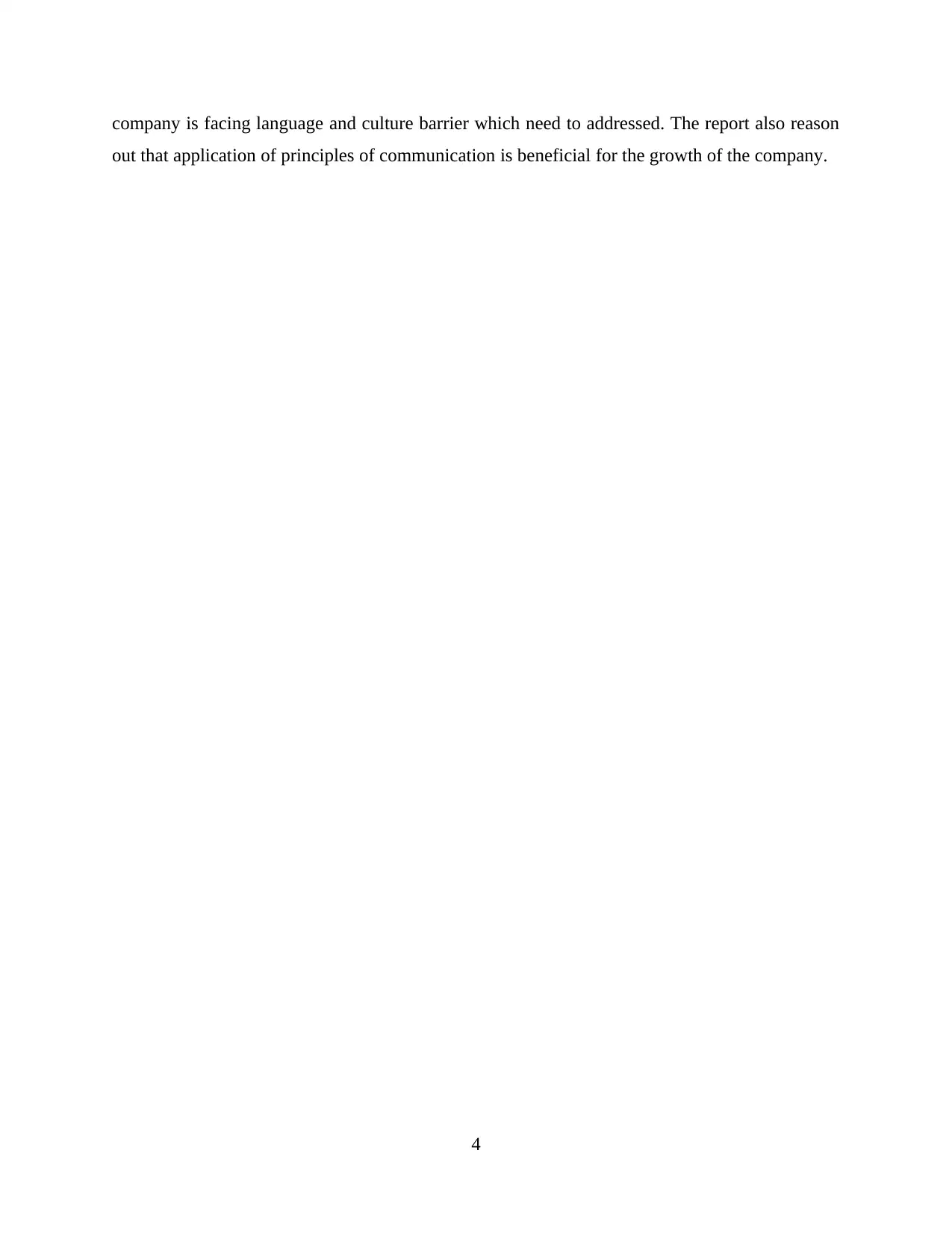
company is facing language and culture barrier which need to addressed. The report also reason
out that application of principles of communication is beneficial for the growth of the company.
4
out that application of principles of communication is beneficial for the growth of the company.
4
⊘ This is a preview!⊘
Do you want full access?
Subscribe today to unlock all pages.

Trusted by 1+ million students worldwide
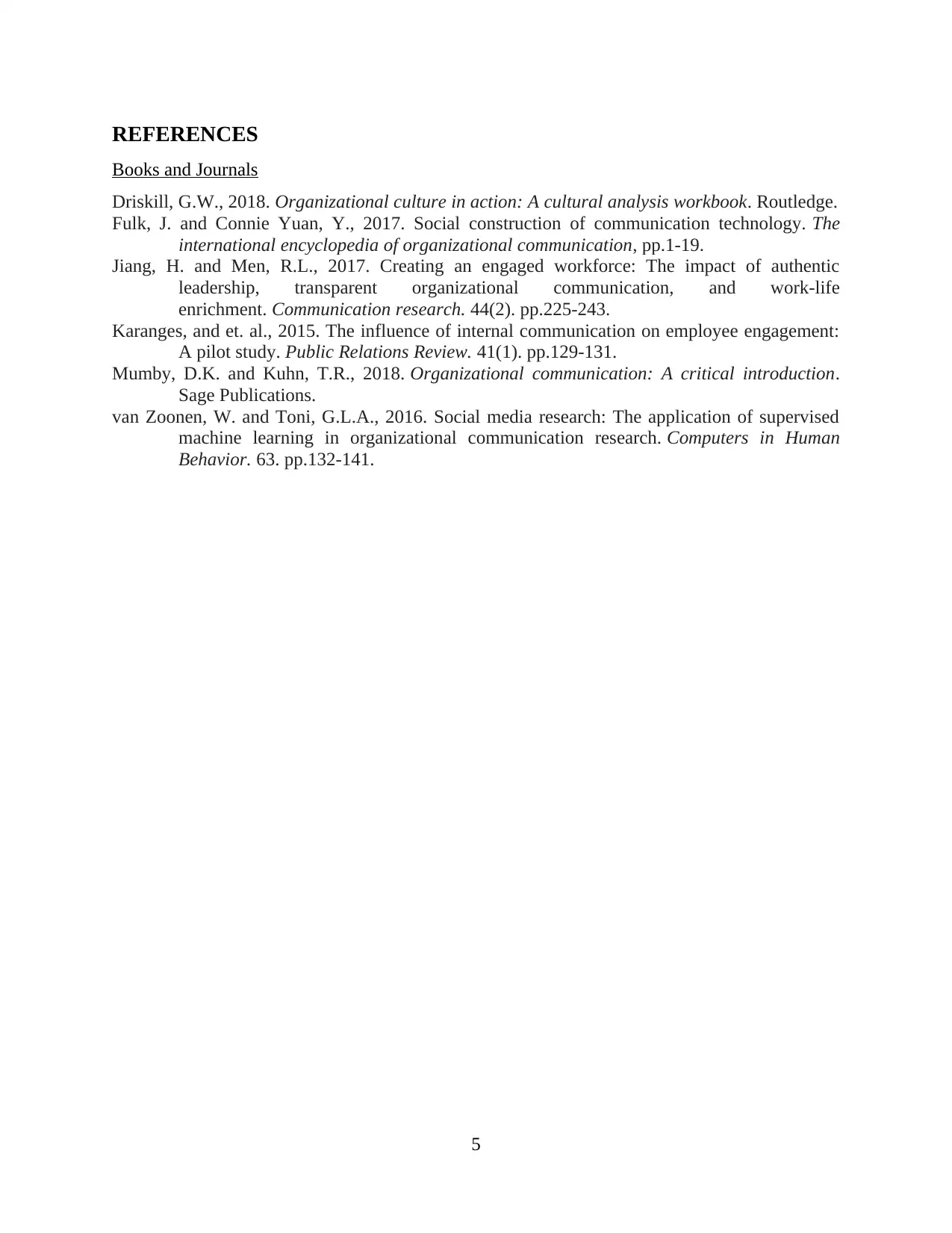
REFERENCES
Books and Journals
Driskill, G.W., 2018. Organizational culture in action: A cultural analysis workbook. Routledge.
Fulk, J. and Connie Yuan, Y., 2017. Social construction of communication technology. The
international encyclopedia of organizational communication, pp.1-19.
Jiang, H. and Men, R.L., 2017. Creating an engaged workforce: The impact of authentic
leadership, transparent organizational communication, and work-life
enrichment. Communication research. 44(2). pp.225-243.
Karanges, and et. al., 2015. The influence of internal communication on employee engagement:
A pilot study. Public Relations Review. 41(1). pp.129-131.
Mumby, D.K. and Kuhn, T.R., 2018. Organizational communication: A critical introduction.
Sage Publications.
van Zoonen, W. and Toni, G.L.A., 2016. Social media research: The application of supervised
machine learning in organizational communication research. Computers in Human
Behavior. 63. pp.132-141.
5
Books and Journals
Driskill, G.W., 2018. Organizational culture in action: A cultural analysis workbook. Routledge.
Fulk, J. and Connie Yuan, Y., 2017. Social construction of communication technology. The
international encyclopedia of organizational communication, pp.1-19.
Jiang, H. and Men, R.L., 2017. Creating an engaged workforce: The impact of authentic
leadership, transparent organizational communication, and work-life
enrichment. Communication research. 44(2). pp.225-243.
Karanges, and et. al., 2015. The influence of internal communication on employee engagement:
A pilot study. Public Relations Review. 41(1). pp.129-131.
Mumby, D.K. and Kuhn, T.R., 2018. Organizational communication: A critical introduction.
Sage Publications.
van Zoonen, W. and Toni, G.L.A., 2016. Social media research: The application of supervised
machine learning in organizational communication research. Computers in Human
Behavior. 63. pp.132-141.
5
1 out of 7
Related Documents
Your All-in-One AI-Powered Toolkit for Academic Success.
+13062052269
info@desklib.com
Available 24*7 on WhatsApp / Email
![[object Object]](/_next/static/media/star-bottom.7253800d.svg)
Unlock your academic potential
Copyright © 2020–2025 A2Z Services. All Rights Reserved. Developed and managed by ZUCOL.





